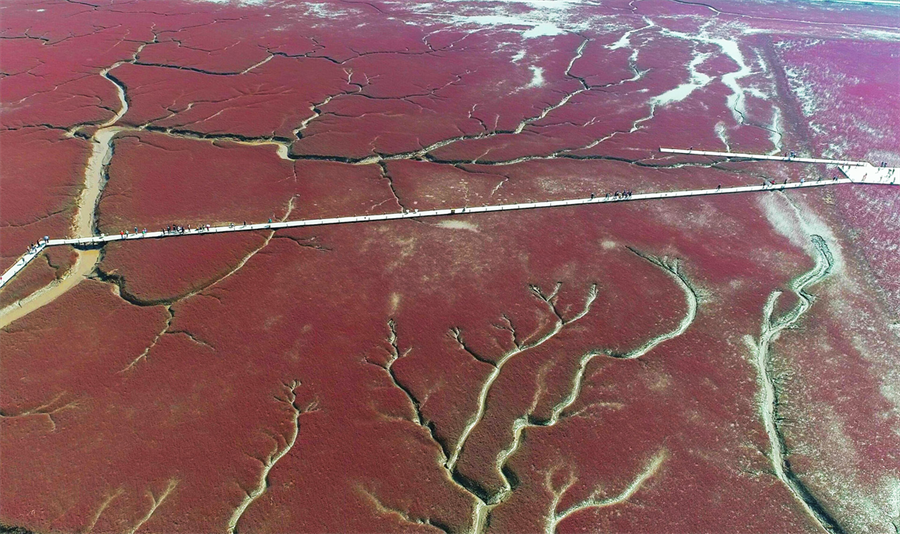Restoring wetland ecology in oil-producing city

Sea grass turns to reddish purple in the coastal wetlands of Panjin, Northeast China's Liaoning province, on Sept 23, 2020. [Photo by Xing Ming/Provided to chinadaily.com.cn]
SHENYANG — Miles of salt marshes dominated by saline seepweed forming a red beach in the northeastern Chinese city of Panjin have become a popular tourist destination as well as an important wetland ecosystem.
The coastal city in Liaoning province is now home to spotted seals, red-crowned cranes, and other rare wildlife thanks to its enhanced wetland ecology. The "red beach" in the city was designated as a 5A scenic site in 2020, the top level in the country in terms of quality.
The city, an oil production base, had long suffered from environmental degradation owing to petrochemical and other industries in the past.
In 2002, local authorities rolled out wetland protection measures and adopted plans to establish nature reserves across the city.
Consequently, the city has nearly 1,100 square kilometers of nature reserves and important wetlands in the ecological protection red line over the past two decades.
In 2004, the city established a fully enclosed breeding base covering 9,100 mu (607 hectares) in Nanxiaohe Wetland, one of the main habitats of Saunders's Gull, a rare bird species.
The base aims to minimize the interference of humans in waterfowl habitat and reproduction, and it regularly undertakes environmental inspections, bird observation, protection, and rescue.
Around 2015, Panjin initiated the implementation of projects to convert agricultural and aquacultural lands into wetlands.
To ensure the interests of farmers, the municipal government offered compensation and assistance to the affected people. As a result, Panjin had achieved the withdrawal of 598 households engaged in aquaculture by 2021, helping restore 85,900 mu of wetlands and 15.77 km of the natural coastline.
In 1991, a non-governmental organization focusing on Saunders's Gull protection was established. Today, the organization has more than 40,000 members who are actively involved in rescuing injured gulls and cleaning garbage on the beach.
Lush greeneries and clear lakes cover much of the urban landscape of Panjin today, with waterfowl frequently spotted in the city.
In recent years, the local government has made use of ditches and rivers formed naturally and artificially in the city, building more than 80 urban wetlands, which have become an ideal destination for residents to indulge in fishing and camping.
Due to the improved environment and infrastructure, Panjin has also attracted a series of international events such as marathons, paramotor championships, and sailing rallies.
In 2021, the city received nearly 30 million tourist trips, raking in a total tourism revenue of 22 billion yuan ($3.06 billion), respectively up 27.6 percent and 15.1 percent year on year.
Xinhua
























